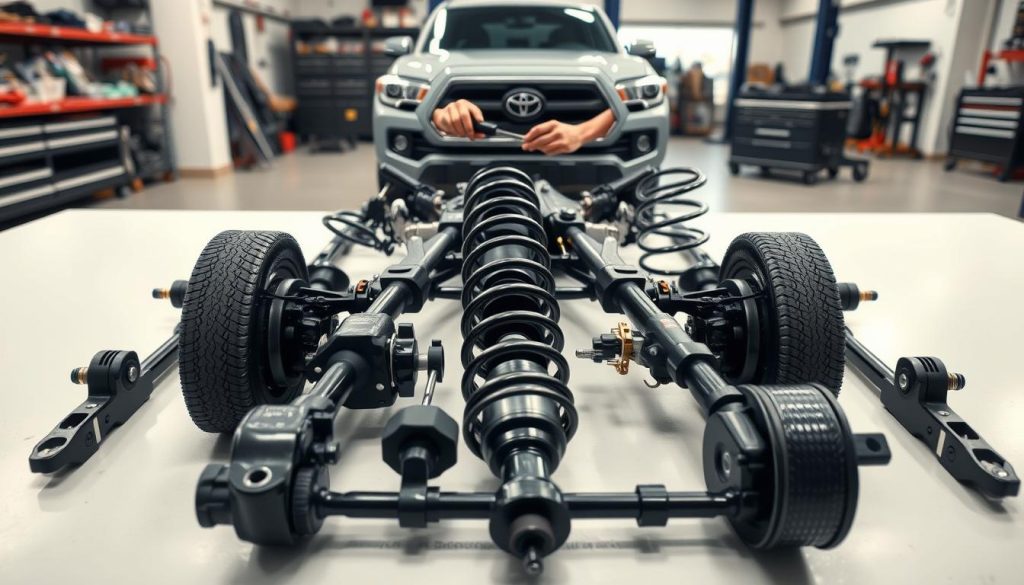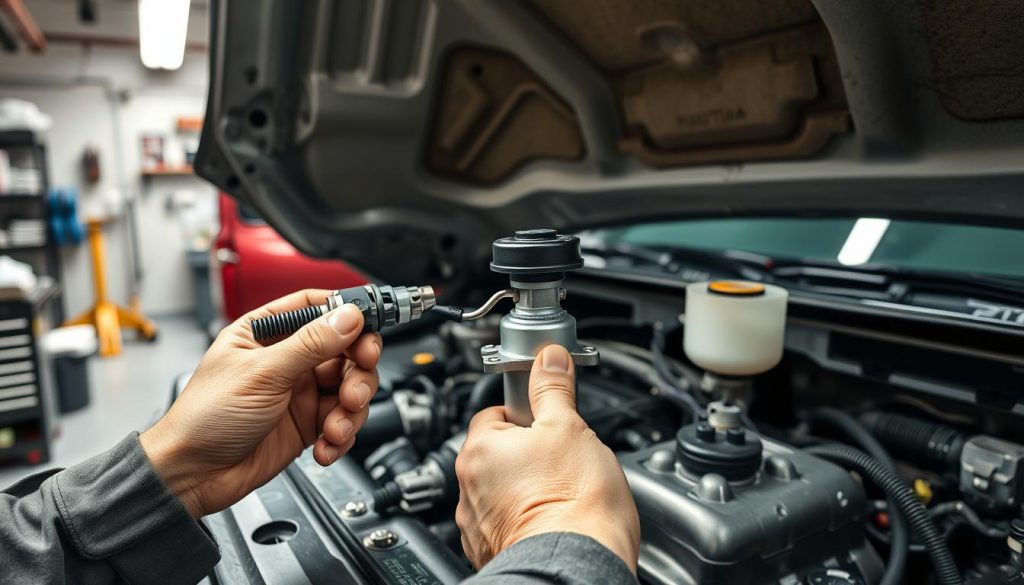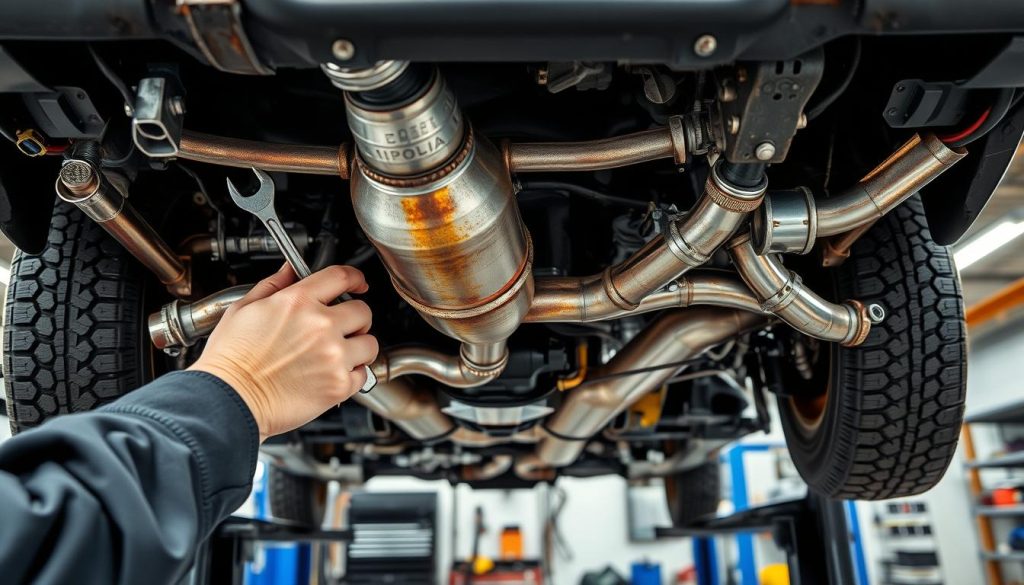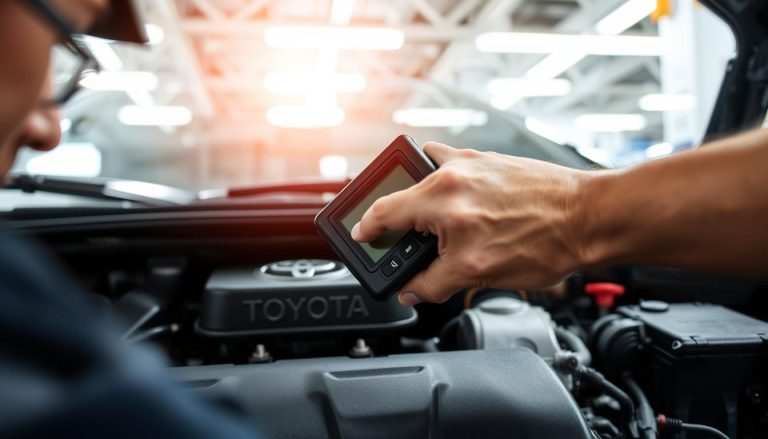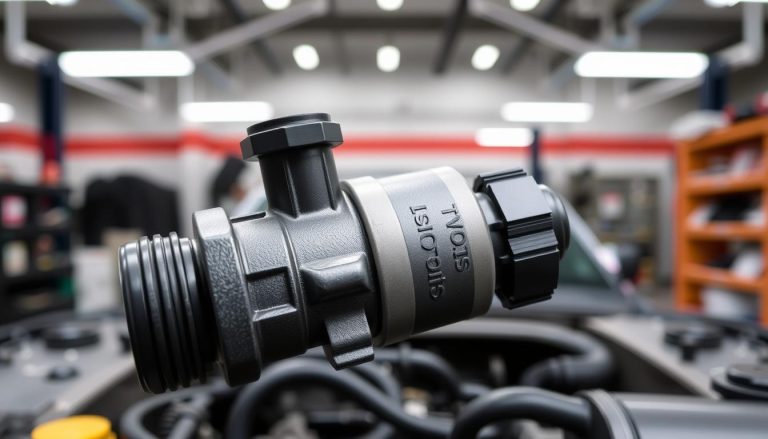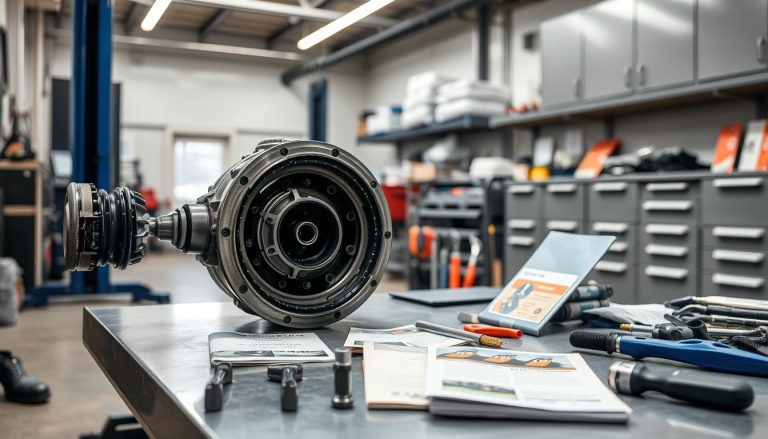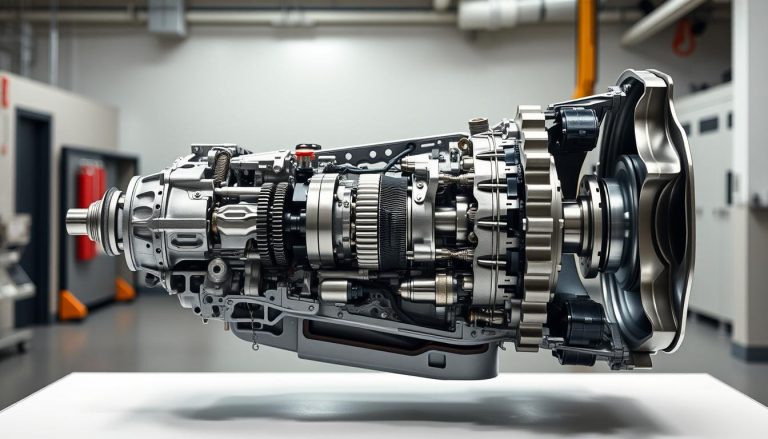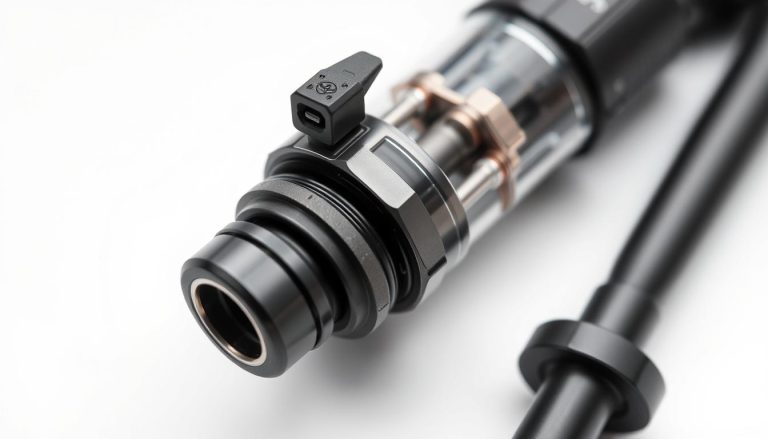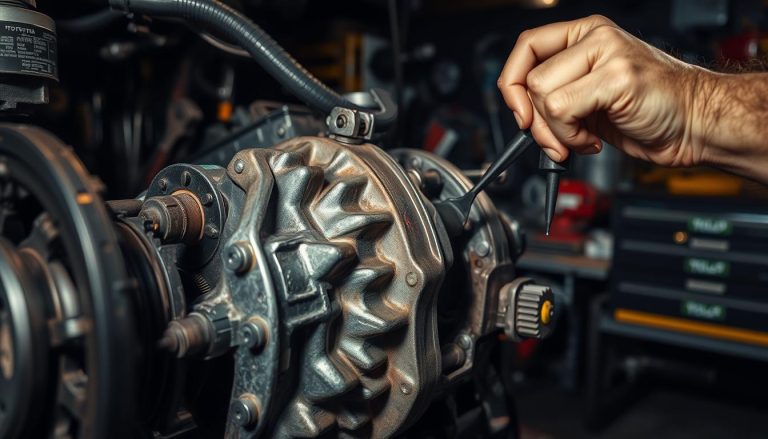Common Toyota Tacoma Problems & Solutions Guide
The Toyota Tacoma reliability has made it America’s favorite midsize truck for sixteen straight years. This pickup maintains an impressive resale value of over 70% after five years on the road.
Even the most dependable vehicles can develop issues over time. Understanding Tacoma truck issues early helps you avoid costly repairs and keeps your pickup running smoothly.
This guide tackles the most frequent Toyota pickup problems with practical solutions. You’ll discover real-world fixes from experienced owners and professional mechanics.
Whether you’re facing transmission concerns, frame rust, or engine performance issues, we’ve got you covered. Our step-by-step approach puts you back in control of your truck’s maintenance and performance.
Key Takeaways
- Tacoma has been America’s top-selling midsize truck for 16 consecutive years
- Early problem identification can save thousands in repair costs
- Common issues include transmission, frame rust, and engine performance concerns
- Third-party inspections are recommended before purchasing used models
- Proper maintenance extends truck lifespan and preserves resale value
- Real-world solutions from owners and mechanics provide practical fixes
Understanding Your Toyota Tacoma’s Reliability Issues
Toyota Tacomas are known for being tough, but they can have problems too. Spotting these issues early can save you a lot of money. Knowing which problems need quick fixes and which can wait is key.
Minor problems often start small and don’t need to be fixed right away. These include small interior wear, minor electrical issues, or routine maintenance. But, serious issues like frame rust and engine problems can be very costly if ignored.
- Immediate concerns: Frame rust, transmission failures, engine timing issues
- Moderate priority: Suspension wear, brake system problems, electrical faults
- Minor issues: Interior wear, cosmetic damage, routine maintenance needs
Before buying a used Tacoma, get it checked by a professional. This can uncover Tacoma reliability problems that might cost you later. Many buyers skip this step and later regret it when big problems show up.
The good news is that most problems are fixable. Toyota truck maintenance schedules can prevent many issues. Regular checks can catch problems early, saving you money.
Knowing your truck’s weak spots is a big advantage. Most common Tacoma failures show warning signs early. Frame rust starts small, engine problems begin with minor symptoms, and transmission issues often signal themselves through shifting changes.
Your Tacoma’s reliability comes from proper care and attention. Even trucks with known issues can last hundreds of thousands of miles. The key is to fix problems quickly when they appear.
Proactive maintenance is your best defense against expensive repairs. Regular check-ups, watching for warning signs, and fixing issues fast will keep your Tacoma running well. This also protects your investment.
Remember, Tacoma reliability problems are often well-documented online. Research common issues for your model year. Join owner forums and learn from others. This way, you can stay ahead of problems.
Most Common Toyota Tacoma Problems and Quick Fixes
Smart Tacoma owners catch problems early to save on repair costs and keep their truck reliable. Your Toyota truck sends signals about its condition. Look for subtle changes in performance and dashboard warning lights.
Common issues include transmission shifting problems, frame rust, engine decline, and suspension wear. These problems don’t appear suddenly. They develop slowly, giving you time to notice warning signs.
Knowing your truck’s normal behavior helps you spot odd patterns quickly. Regular driving makes you familiar with its sounds, feel, and responses.
Identifying Warning Signs Early
Effective Tacoma warning signs detection starts with your senses. Listen for unusual noises like grinding, squealing, or rattling. These sounds often mean problems with brakes, suspension, or engine.
Feel for changes in handling. Does the steering wheel vibrate at highway speeds? Has the ride become rougher? These physical sensations can point to tire, alignment, or suspension issues.
Watch your dashboard warning lights closely. Modern Tacomas have systems that alert you to problems early. Don’t ignore check engine lights, transmission temperature warnings, or oil pressure indicators.
Regularly monitor your truck’s performance metrics. Toyota truck diagnostics are easier when you track fuel economy, acceleration, and shifting patterns. Sudden changes often signal mechanical issues.
Priority Problem Assessment
Not all Tacoma problems need immediate attention, but knowing which ones do is key. Tacoma problem identification helps you categorize issues by urgency and safety.
Immediate priority problems include brake failures, steering issues, engine overheating, and frame rust. These issues are safety risks and need quick professional help.
Medium priority concerns are transmission hesitation, minor oil leaks, worn suspension, and electrical glitches. These problems won’t strand you right away but can get worse if ignored.
Low priority items include cosmetic damage, minor interior wear, and routine maintenance. You can schedule these repairs during regular maintenance without risking safety or performance.
Creating a simple inspection routine helps you stay ahead of problems. Check fluid levels weekly, inspect tires monthly, and listen for unusual sounds. This proactive approach keeps your Tacoma running smoothly and helps you budget for repairs.
Transmission Problems and Repair Solutions
Knowing about Tacoma transmission problems helps keep your truck running smoothly. The transmission works hard every day. Spotting early signs can save you a lot of money.
Third-generation Tacomas from 2016 have specific issues with their 6-speed automatic systems. Toyota has released service bulletins to address these problems. Most transmission issues have proven solutions with the right approach.
Automatic Transmission Shifting Issues
Toyota automatic transmission issues often show up as gear hunting and poor throttle response. Your Tacoma might struggle to find the right gear on hills or feel jerky when accelerating. These issues make driving unpleasant and affect your daily commute.
The 6-speed automatic transmission has programming issues more than mechanical failures. It hunts between gears, causing uneven power delivery and unpredictable throttle response. This makes driving uncomfortable.
Start by checking the transmission fluid levels and condition. Dirty or low fluid often causes shifting problems. Look for these warning signs:
- Fluid appears dark brown or black instead of bright red
- Burning smell from the transmission area
- Fluid level below the minimum mark on the dipstick
- Metal particles visible in the fluid
Professional transmission tuning can solve persistent shifting issues. Many owners see big improvements after tuning solutions that adjust shift points and timing.
Manual Transmission Clutch Problems
Tacoma clutch repair is needed for trouble engaging gears or clutch slippage. Manual transmission owners face different challenges than automatic users. But, the solutions are often simpler.
Common clutch problems include premature wear and hard shifting. Your clutch pedal might feel spongy or need more pressure. These signs mean internal wear or hydraulic system issues that need fixing.
Clutch replacement involves major components:
- Clutch disc: The friction surface that engages and disengages power
- Pressure plate: Applies clamping force to the clutch disc
- Release bearing: Allows smooth clutch operation
- Flywheel resurfacing: Ensures proper disc contact surface
Professional installation is key for proper torque and alignment. DIY attempts can damage the transmission or pose safety risks.
Step-by-Step Transmission Fluid Change
Changing transmission fluid every 30,000 to 60,000 miles prevents many problems and extends life. This maintenance improves shifting quality and protects internal components.
Follow these steps for proper fluid service:
- Warm the transmission: Drive for 10-15 minutes to reach operating temperature
- Locate the drain plug: Position your Tacoma on level ground and locate the transmission pan
- Drain old fluid: Remove the drain plug and allow complete drainage
- Replace the filter: Remove the transmission pan and replace the internal filter
- Install new gasket: Clean the pan thoroughly and install a new gasket
- Add fresh fluid: Use only Toyota-approved ATF through the dipstick tube
Check fluid levels with the engine running and transmission warm. Add fluid gradually to avoid overfilling, which can cause foaming and shifting problems. The correct fluid level sits between the minimum and maximum marks on the dipstick.
Never mix different types of transmission fluid or use generic substitutes. Toyota transmissions require specific fluid formulations to function properly. Using incorrect fluid can damage seals and internal components.
If problems persist after fluid service, consider professional diagnostics. Modern transmissions include computer controls that may require specialized equipment to diagnose properly.
Frame Rust Prevention and Treatment Methods
Knowing how to prevent frame rust can save Toyota Tacoma owners a lot of money. Your truck’s frame is very important, and keeping it from rusting is key. Tacoma frame rust starts small but can become a big problem if not fixed right away.
Things like salt, moisture, and road debris can harm your truck’s frame. Trucks in northern states face even tougher conditions in winter. Regular checks and care can help avoid big repairs.
Identifying Early Rust Signs
Spotting Tacoma frame rust early is very important. Look for brown or orange spots on your frame. These signs often show up around bolts, welds, and brackets.
Paint bubbling means rust is forming under the paint. Small flakes or chips in the paint expose metal to moisture and salt. Areas where mud and debris collect are also at risk.
Check your frame every month in winter and after trips through salty areas. Use a flashlight to see under your truck. Take photos of any rust spots to track them.
“The key to preventing major frame damage is catching rust in its early stages when treatment options are simple and affordable.”
DIY Rust Treatment Steps
Toyota truck rust prevention starts with cleaning and preparing. Use wire brushes, sandpaper, or steel wool to remove loose rust. Clean the area well with degreaser to get rid of oil, dirt, and salt.
Apply rust converter to stop the rust. These chemicals turn rust into a protective coating. Always follow the product instructions and let it dry fully between applications.
Prime the area with a good metal primer. Choose ones that resist corrosion and stick well. Apply thin, even coats, not one thick layer.
Finish with matching paint or protective coating. Many people use rubberized undercoatings for extra protection. Regularly reapplying these coatings helps your frame last longer.
Professional Frame Repair Options
When rust damage is serious, you need a pro for frame corrosion repair. DIY methods can’t fix holes or weak spots. Experts have the right tools for a proper fix.
Welding repairs involve cutting out bad spots and adding new metal. Technicians make sure it’s strong and right. Sometimes, they add reinforcement plates for extra strength.
For really bad damage, you might need to replace a whole frame section. This big job means removing parts to fix the frame. Shops can use OEM parts or make custom ones as needed.
| Rust Severity Level | Treatment Method | Estimated Cost | Time Required |
|---|---|---|---|
| Surface Rust | DIY wire brush and primer | $25-50 | 2-4 hours |
| Moderate Corrosion | Professional sandblasting and coating | $200-500 | 1-2 days |
| Structural Damage | Welding repairs and reinforcement | $800-2000 | 3-5 days |
| Severe Compromise | Frame section replacement | $2000-5000 | 1-2 weeks |
Preventing rust is the best way to keep your truck’s frame in good shape. Regular washing gets rid of salt and debris that cause rust. Apply protective coatings every year, before winter in salt areas.
Fixing rust quickly is key to avoiding big problems. With the right care, your Toyota Tacoma’s frame can last for decades.
Engine Performance Issues and Repair Guide
Your Toyota Tacoma’s engine is its heart. When problems pop up, they need quick action. Issues can range from annoying rattles to serious problems that affect safety and reliability.
Engine problems often start small but can grow. Catching them early can save money and time. Keeping an eye on your engine helps avoid big repairs.
Timing Chain Rattle Solutions
Toyota timing chain issues show up as a metallic rattle at cold starts. This sound usually goes away as the engine warms up. But ignoring it can cause serious damage.
The timing chain stretches over time, leading to slack and rattling. Cold engine oil makes this noise louder at startup. A pro can tell if you need a new chain.
“A rattling timing chain is like a ticking time bomb – address it early to avoid complete engine failure.”
Replacing the timing chain needs special tools and skills. Most Tacoma owners should get a pro to do this job. Costs range from $1,500 to $3,000, depending on the damage.
Oil Consumption Problem Fixes
Many Tacomas have oil consumption issues, more so with high mileage. Normal oil use should not exceed one quart between changes.
Worn piston rings, damaged valve seals, or PCV system problems can cause this. Check the PCV valve first, as it’s often the culprit.
Check oil levels weekly and keep records. This helps spot patterns and helps mechanics find the problem.
For small oil leaks, try high-mileage oil. It has seal conditioners that can help older engines.
Engine Maintenance Procedures
Regular maintenance is key to a long-lasting engine. Oil changes every 5,000 to 10,000 miles keep it running smoothly.
Change air filters every 12,000 to 15,000 miles or sooner in dusty areas. Clean filters ensure good airflow and performance.
Check coolant levels monthly and flush the system every 60,000 miles. Coolant issues can cause overheating and damage.
Look at belts and hoses during maintenance. Worn belts or hoses can cause leaks or overheating.
Suspension System Problems and Fixes
Toyota Tacoma suspension problems make driving tough. Many say it feels too stiff and too soft at the same time. This is because the stock parts wear out and don’t control the truck well.
Stock parts often can’t handle different driving needs. Owners feel a rubbery or disconnected feel on various roads. This is more noticeable on highways or when the truck is loaded.
Signs of suspension failure include bouncing over bumps and diving when braking. The truck may also wear out tires unevenly or have trouble staying straight. These problems get worse over time, affecting how well the truck rides.
Leaf Spring Replacement Guide
Replacing leaf springs fixes rear sagging and a harsh ride. Start by lifting your Tacoma safely with jack stands. Never use a hydraulic jack alone.
Take off the rear wheels and disconnect the shock absorbers. Use a floor jack to support the rear axle before removing the leaf spring hardware. Use penetrating oil on the bolts to avoid corrosion.
Put in new leaf springs by following the removal steps in reverse. Apply anti-seize to bolts and tighten as the manual says. New springs may feel stiff at first but will soften as they break in.
Shock Absorber Troubleshooting Steps
Shock absorber problems affect handling and comfort. Start by looking for oil leaks. Leaks mean the seals are bad and need to be replaced.
Do the bounce test by pushing down on each corner. A good shock lets you bounce once before settling. If it bounces more or takes a long time to settle, it’s worn out.
Check the mounting hardware for looseness or damage. Worn bushings cause clunking and allow too much movement. Replace both shocks on each axle to keep performance balanced.
Think about getting aftermarket parts if stock ones don’t work. Better shocks and springs can fix the rubbery feel. They also improve load-carrying and off-road performance.
Electrical System Troubleshooting Methods
Your Toyota Tacoma’s electrical system is key to many functions. It starts your engine and powers your headlights. A healthy charging system and clean connections are essential.
When Tacoma electrical problems happen, they can be frustrating. They often seem to come and go without warning.
Using systematic troubleshooting methods can help fix most electrical issues. It’s important to understand how components work together. Knowing which tests to do first is also key.
Battery and Alternator Testing
Testing your battery and alternator is the first step when you have electrical problems. These parts power your whole electrical system. A weak battery or failing alternator can cause many issues.
Start by checking your battery terminals for corrosion. Clean them with a baking soda and water mix. This keeps connections good and prevents voltage drops.
Check your battery voltage often. It should be 12.6 volts when the engine is off. Replace your battery every three years to avoid failures, even in extreme weather.
Alternator testing checks charging voltage while the engine runs. It should be 13.5 to 14.5 volts at idle. If it’s lower or higher, your alternator needs a pro to fix it. Use a digital multimeter for accurate readings.
Wiring Harness Inspection Process
Inspecting your wiring harness is key for intermittent electrical problems. These issues often come from damaged wires or loose connections. A systematic approach helps find problem areas fast.
Look at areas where wires rub against metal or moving parts. Engine bay wiring gets damaged by vibration and heat. Check for signs of damage in wire coverings.
Check connections that might have come loose. Pay extra attention to ground connections. Clean and tighten any loose connections you find.
Watch for signs of rodent damage or corrosion, where moisture can build up. Rodents often chew on wiring, causing shorts or open circuits.
Dashboard Warning Light Solutions
Dashboard warning lights often show the first sign of electrical problems. Knowing what each light means helps you fix issues quickly. Modern Tacomas have systems that detect problems early.
The battery warning light means charging system issues. The check engine light can signal many electrical problems. Oil pressure and temperature lights might show sensor problems, not mechanical issues.
Keep a basic electrical testing kit handy. It includes a multimeter and test light. This lets you diagnose problems and decide if you need a pro right away.
| Warning Light | Common Causes | Immediate Action | Repair Priority |
|---|---|---|---|
| Battery Light | Alternator failure, loose belt, bad connections | Check charging voltage | High |
| Check Engine | Sensor malfunction, wiring issues, emissions problems | Scan for diagnostic codes | Medium |
| Oil Pressure | Faulty sensor, low oil level, pump problems | Check oil level immediately | High |
| Temperature | Thermostat sensor, cooling fan relay, wiring | Monitor coolant temperature | High |
Regular maintenance keeps your Tacoma’s electrical system working well. Clean battery terminals monthly and check wiring during oil changes. Fixing warning lights quickly also helps. These steps ensure your Tacoma runs smoothly for years.
Brake System Maintenance and Repair Steps
Regular brake maintenance on your Toyota Tacoma is key to safe stops. Your truck’s brakes work hard, more than any other part, when you’re hauling heavy loads or driving in tough conditions. Proper Tacoma brake maintenance prevents dangerous brake failure and saves money on emergency repairs.
Brake inspections should happen every 5,000 to 10,000 miles to catch problems early. During these checks, look for worn brake pads, damaged rotors, and fluid leaks. Early detection of brake issues keeps your family safe and prevents costly damage to other brake components.
The brake system includes several key parts that need regular attention. Brake pads create friction to stop your truck, while brake fluid transfers pressure from your foot to the wheels. Both require different maintenance schedules and procedures.
| Brake Component | Inspection Interval | Replacement Schedule | Warning Signs |
|---|---|---|---|
| Brake Pads | Every 10,000 miles | 25,000-70,000 miles | Squealing, grinding sounds |
| Brake Fluid | Monthly | 30,000-50,000 miles | Dark or murky appearance |
| Brake Rotors | Every 20,000 miles | 50,000-100,000 miles | Vibration when braking |
| Brake Lines | Every 15,000 miles | As needed | Visible cracks or leaks |
Brake Pad Replacement Procedure
Brake pad replacement requires careful attention to safety and proper procedures. Start by parking on level ground and engaging the parking brake. Never work under a vehicle supported only by a jack – always use jack stands for safety.
Remove the wheel to access the brake caliper. The caliper holds the brake pads against the rotor. Carefully remove the caliper bolts and lift the caliper away from the rotor. Support the caliper with wire or a bungee cord to prevent damage to the brake line.
Old brake pads slide out of the caliper bracket. Before installing new pads, compress the caliper piston using a C-clamp or brake piston tool. This creates space for the thicker new pads. Always replace brake pads in complete axle sets to maintain balanced braking.
Brake Fluid System Maintenance
Brake fluid service keeps your stopping power consistent and reliable. Check fluid levels monthly by looking at the brake fluid reservoir under the hood. Clean brake fluid appears clear or light amber, while contaminated fluid looks dark or murky.
Brake fluid absorbs moisture over time, which reduces its effectiveness. Water in brake fluid can cause brake fade during heavy use and leads to internal corrosion. Complete brake fluid service every 30,000 to 50,000 miles prevents these problems.
During brake fluid service, technicians remove old fluid from the entire system and replace it with fresh fluid. This process requires bleeding air from brake lines at each wheel. Proper bleeding technique ensures no air bubbles remain in the system, which could cause a spongy brake pedal feel.
Air Conditioning System Repair Guide
When your Toyota Tacoma’s air conditioning blows warm air, finding the cause fast is key. Tacoma AC problems can sneak up on you, but catching them early saves money and keeps you cool. Knowing the signs helps fix issues before they get worse.
Most air conditioning repair needs come from compressor failures or refrigerant leaks. These issues can make your car hot during summer. Getting a pro to diagnose the problem saves time and money.
AC Compressor Problem Diagnosis
AC compressor issues often show up with specific warning signs. Listen for grinding, squealing, or clicking noises from the engine bay when the AC is on. These sounds mean the compressor or its clutch might be damaged.
Check if the compressor clutch works right when you turn on the AC. It should click and the center hub should spin. If it doesn’t, you might have electrical issues or low refrigerant.
Watch how your AC cools in different driving conditions. If it cools only sometimes, the compressor might be failing. Complete loss of cooling means the compressor needs to be replaced right away.
Refrigerant Leak Detection Methods
Refrigerant leaks cause cooling to fade over time. Look for oily spots around AC parts, like hose connections and the condenser. This oily mess means refrigerant and compressor oil have leaked out.
Experts use special tools and UV dyes to find leaks. But you can do a quick check yourself. Look for too much moisture or strange smells around the evaporator drain.
Low refrigerant levels can hurt the compressor by removing needed lubrication. Never add refrigerant yourself. Environmental regulations require a pro to handle refrigerant services.
| AC Problem Type | Common Symptoms | Typical Causes | Repair Complexity |
|---|---|---|---|
| Compressor Failure | No cooling, grinding noise | Internal wear, clutch damage | Professional required |
| Refrigerant Leak | Gradual cooling loss | Worn seals, damaged hoses | Professional required |
| Electrical Issues | Intermittent operation | Bad relays, wiring problems | Moderate DIY possible |
| Blocked Condenser | Poor cooling at idle | Debris, bent fins | Easy DIY cleaning |
Regular AC system checks can stop most problems before they start. Get an annual check-up in spring to keep your AC running well all summer. A pro can spot issues early and fix them right, using the right methods and materials.
Fuel System Problems and Solutions
Knowing how your Toyota Tacoma’s fuel system works helps you spot problems early. This can save you from expensive breakdowns. The system includes parts that work together to deliver fuel correctly.
Common Tacoma fuel system issues can sneak up on you. You might notice your truck hesitates when you accelerate or won’t start well in the cold. These signs often mean there’s a problem with fuel pressure or dirty fuel injectors.
Modern Tacomas have advanced fuel systems that need clean fuel and the right pressure. Direct injection engines in newer models are very sensitive to fuel quality. Regular care helps avoid most problems and keeps your truck running well.
The fuel system works under high pressure, so safety is key when fixing it. Always release fuel pressure before starting repairs. Work in a well-ventilated area, away from sparks. Tools like professional diagnostic equipment help find problems accurately.
Fuel Pump Replacement Steps
Fuel pump problems often start with small issues before failing completely. Your Tacoma’s fuel pump is inside the tank, making it harder to replace than older pumps. Look out for whining noises, engine hesitation, and hard starts.
Before you start, get the right tools and safety gear. You’ll need hand tools, a fuel pressure gauge, and safety glasses and gloves. This job takes several hours because it needs careful attention.
Here are the key steps for safe fuel pump replacement:
- Drain the fuel tank to make it lighter and reduce spills
- Remove the truck bed or drop the tank to get to the pump
- Disconnect electrical connections and fuel lines safely
- Remove the pump assembly by unscrewing the retaining ring
- Install the new pump with a new gasket and tighten the ring correctly
- Reconnect all connections and check for leaks before putting everything back
After installing the new pump, test it by cycling the ignition a few times. Use a gauge to check the fuel pressure. Proper installation helps avoid early failure and ensures your truck runs right.
Fuel Injector Cleaning Process
Regular fuel injector cleaning keeps your engine running well and saves money. Dirty injectors cause rough idling, poor acceleration, and bad fuel economy. Carbon buildup on the tips disrupts the fuel spray needed for good combustion.
Direct injection engines need more frequent cleaning because of their design. Unlike older systems, direct injectors spray fuel directly into the combustion chamber, where it faces high temperatures and combustion byproducts.
You can clean fuel injectors yourself with quality cleaners:
- Add fuel system cleaner to a nearly empty tank before filling up
- Drive normally for a full tank to let the cleaner work
- Use high-quality gasoline with additives for regular care
- Repeat the process every 3,000 to 5,000 miles to prevent problems
Professional fuel injector cleaning uses ultrasonic equipment to remove tough carbon deposits. This deep cleaning can’t be done with additives alone. It’s cheaper than replacing injectors and brings back your truck’s performance.
Signs you need professional cleaning include a rough idle after using additives, big drops in fuel economy, and failed emissions tests. Professional service also includes flow tests to make sure all injectors work equally.
Preventing injector problems starts with using good fuel and changing the fuel filter on time. Don’t let your tank get too low, as it can draw in sediment. Regular care stops most Tacoma fuel system issues and keeps your truck running smoothly for years.
Exhaust System Repair Procedures
Your Toyota Tacoma’s exhaust system is key for performance and meeting environmental rules. Tacoma exhaust problems can hurt fuel efficiency, safety, and emissions tests. They also make your vehicle noisier.
The exhaust system has important parts like the catalytic converter and muffler. The catalytic converter cuts down on harmful emissions. The muffler keeps the noise down. Oxygen sensors check the exhaust to help the engine run better.
Regular checks can spot issues early. Look for rust, holes, or loose parts. Unusual sounds or black smoke or strong odors mean you need to act fast.
Catalytic Converter Issue Resolution
Catalytic converter issues have clear signs. If your car doesn’t accelerate well, fails emissions tests, or smells like sulfur, it’s a problem. The check engine light might also come on.
Getting a proper diagnosis is key before replacing the converter. Often, problems seem to be in the converter but are really elsewhere. Issues like faulty oxygen sensors or engine misfires can mimic converter problems.
Testing involves checking exhaust temperatures and emissions. A scan tool can read codes for the converter. Temperature readings show if the converter is working right.
Choosing the right part for your model is important. Emissions rules differ by area. Always pick converters that meet or exceed the original equipment’s standards.
Muffler Replacement Guide
Muffler replacement is a simpler fix. Look for loud exhaust, rust, holes, or rattling sounds from the back. These are signs it needs to be replaced.
Before starting, make sure you’re safe. Park on flat ground and let the exhaust cool down. Use jack stands to support the car safely.
Removing the muffler means cutting or unbolting it. Spray penetrating oil on rusty bolts. Be careful with exhaust hangers to avoid damage.
When installing, align everything right and connect securely. Use new gaskets and clamps for a tight seal. Proper hanger placement stops vibration and wear.
When picking new parts, think about what you want. Stock parts keep the sound and emissions right. Upgrades can improve sound and power, but check local laws first.
Interior and Exterior Wear Prevention
Keeping your Tacoma’s interior and exterior in top shape saves money and keeps your truck’s value high. It’s smarter to prevent damage than to fix it later. Your truck deals with weather, dirt, and daily wear every day.
Regular care keeps your Tacoma looking great and feeling comfortable. Quality protection methods can make your truck last longer. Small investments in maintenance can save a lot of money later.
Seat Fabric Protection Methods
Start with the right protection for your Tacoma’s seats based on how you use it. Work trucks need tough seat covers that can handle tears and stains. Drivers who use their truck daily should choose breathable fabric protectors that keep things comfy.
Quality seat covers are your first line of defense against damage. Look for covers made from strong materials like canvas or neoprene. These materials block water, oil, and everyday wear.
Fabric protection sprays create a shield against spills and stains. Spray these products every three months for the best effect. Scotchgard and similar products work well on factory upholstery.
Regular vacuuming stops dirt from getting into fabric fibers. Use a soft brush attachment weekly. Clean spills right away with clean cloths and the right cleaners.
| Protection Method | Cost Range | Durability | Best For |
|---|---|---|---|
| Heavy-duty seat covers | $150-$300 | 3-5 years | Work trucks |
| Fabric protection spray | $15-$25 | 3-4 months | Light use vehicles |
| Leather conditioning | $20-$40 | 2-3 months | Leather interiors |
| Professional detailing | $100-$200 | 6 months | Show condition |
Paint Maintenance Techniques
Paint maintenance is key to keeping your Tacoma’s exterior looking good and its value up. Your truck’s paint faces many dangers like UV rays, road salt, and pollution. Proper washing techniques can prevent most paint damage.
Begin every wash with a good rinse to remove loose dirt. Use high-quality car wash soap as directed. Microfiber wash mitts clean well without scratching.
Wash from top to bottom to avoid spreading dirt. Rinse your mitt often in clean water to prevent grime buildup.
Dry your Tacoma with clean microfiber towels or a quality chamois. Water spots form fast in sunlight. Park in shade when washing and drying.
Apply wax or ceramic coatings every three to four months for top protection. These products block UV damage and pollution. Quality products like Meguiar’s or Chemical Guys work great.
Fix paint chips and scratches right away to stop rust. Use touch-up pens for small chips. For bigger damage, see a pro to keep your truck looking good.
Regular cleaning keeps your Tacoma’s interior in shape. Use the right cleaners for different materials. UV protectant sprays help prevent fading and cracking in sunny areas.
Interior protection goes beyond cleaning. Proper ventilation and temperature control are also important. Crack windows slightly when parked to reduce heat. Use sunshades to protect dashboard and seats from direct sunlight.
Preventive Maintenance Schedule for Tacoma Owners
Smart Toyota Tacoma owners follow a preventive maintenance routine. This routine saves money and prevents breakdowns. Preventive maintenance keeps your truck running well and avoids expensive repairs. It extends your Tacoma’s lifespan and keeps it reliable.
Regular maintenance is key to truck care. Oil changes every 5,000 to 10,000 miles keep the engine smooth. Tire rotations at the same intervals ensure even wear. Brake system inspections should happen every 5,000 to 10,000 miles to catch issues early.
Filter replacements are important for performance. Air and cabin filters need replacement every 15,000 to 30,000 miles, depending on driving conditions. Battery maintenance includes regular terminal cleaning to prevent corrosion. Spark plug replacement intervals range from 30,000 to 100,000 miles based on your engine type.
Monthly Inspection Checklist
Monthly inspections catch problems early, saving money. A thorough routine inspection takes just 30 minutes. It can save thousands in repair costs. Keep a maintenance log to track patterns and identify recurring issues.
Start your monthly check by examining all fluid levels. Check engine oil, coolant, brake fluid, and power steering fluid for proper levels and condition. Dark or contaminated fluids indicate the need for immediate service.
Tire inspection reveals important safety information. Check tire pressure monthly using a reliable gauge, and examine tread wear patterns for signs of alignment issues. Look for cuts, bulges, or embedded objects that could cause sudden failure.
- Inspect battery terminals for corrosion or loose connections
- Listen for unusual noises during engine operation
- Check all lights and signals for proper operation
- Examine belts and hoses for cracks or wear
- Monitor dashboard warning lights and address promptly
Seasonal Maintenance Tasks
Seasonal maintenance adapts your Tacoma maintenance schedule to weather-related challenges and changing driving conditions. Each season brings specific requirements that help maintain optimal performance year-round. Planning seasonal tasks prevents weather-related breakdowns and extends component life.
Spring maintenance focuses on cleaning winter damage and preparing for warmer weather. Remove salt and debris accumulated during winter months, which can cause corrosion if left untreated. Test your air conditioning system before hot weather arrives, and inspect suspension components for winter damage.
Summer preparation emphasizes cooling system performance and heat protection. Service your cooling system to prevent overheating during hot weather driving. Assess tire condition for high-temperature performance, and protect interior surfaces from UV damage with appropriate covers or treatments.
Fall maintenance prepares your truck for harsh winter conditions ahead. Test your battery before cold weather reduces its capacity, and check your heating system for proper operation. Inspect antifreeze levels and concentration to ensure adequate freeze protection.
Winter care involves adapting to cold weather requirements. Switch to appropriate oil viscosity for cold weather starting, and ensure proper tire tread depth for winter traction. Monitor weather forecasts and adjust maintenance timing as needed.
Long-term Care Strategies
Long-term maintenance strategies focus on major component service intervals and overall vehicle preservation. Following manufacturer service intervals for critical components like timing belts, transmission service, and differential maintenance prevents catastrophic failures. Preventive maintenance planning helps budget for predictable expenses.
Maintain detailed service records to support warranty claims and preserve resale value. Document all maintenance performed, including dates, mileage, and parts used. Complete records demonstrate proper care to both buyers and service technicians.
Plan for major service intervals by setting aside funds regularly. Transmission service, timing belt replacement, and other major maintenance items require significant investment but prevent much costlier repairs. Create a maintenance savings account to spread these costs over time.
Consider your driving conditions when planning maintenance intervals. Severe driving conditions like frequent towing, dusty environments, or stop-and-go traffic may require more frequent service. Adjust your maintenance schedule to maintain optimal performance and reliability.
Conclusion
Your Toyota Tacoma is a top choice for midsize trucks in America. This guide has given you the tools to face any challenge.
Toyota Tacoma reliability is real, not just a claim. By following the truck maintenance tips, you can avoid big repairs.
Being a good Tacoma owner means staying ahead of issues. Check for rust, keep your transmission fluid fresh, and follow the maintenance schedule. Each step you take helps your truck last longer.
Your Tacoma is made for tough jobs and rough terrain. Use the repair and maintenance tips from this guide to keep it running strong for years.
Every check-up and maintenance task you do is an investment in your truck’s future. Keep this guide close, stay proactive, and enjoy the peace of mind that comes with knowing your vehicle.
FAQ
What are the most common Toyota Tacoma problems I should watch for?
Watch out for transmission issues, like shifting problems in newer Tacomas. Frame rust is common in salty areas. Engine troubles, like timing chain rattle and oil leaks, can also happen. Suspension wear can make driving feel bumpy.
Regular checks can catch these issues early. This way, you can fix them before they cost a lot.
How serious are Toyota Tacoma transmission problems and can they be fixed?
Transmission issues, like hunting between gears, are serious. Toyota has acknowledged these problems. Most can be fixed with the right fluid changes and professional help.
Using Toyota-approved ATF and getting a tune-up can greatly improve shifting.
How can I prevent and treat frame rust on my Toyota Tacoma?
Prevent rust by washing your Tacoma often and using protective coatings. Treat rust spots quickly during inspections. For DIY fixes, clean with wire brushes, use rust converters, and prime and paint with automotive products.
Look for early signs like discoloration and flaking metal. Advanced rust needs a pro.
What causes timing chain rattle in Toyota Tacomas and how urgent is this repair?
A timing chain rattle means wear and needs quick attention. It’s a sign of trouble that can damage your engine. Replacing the timing chain is complex and should be done by a pro.
Don’t wait to fix it once you hear the rattle.
How often should I change my Toyota Tacoma’s transmission fluid?
Change transmission fluid every 30,000-60,000 miles, depending on how you drive. Regular changes help avoid shifting problems. Always use Toyota-approved ATF and follow the right steps to avoid air in the system.
What are the warning signs of brake system problems in my Tacoma?
Look out for squealing or grinding noises and if your brakes don’t work as well. Changes in brake pedal feel and dark brake fluid are also signs. Check brakes every 5,000-10,000 miles and flush brake fluid every 30,000-50,000 miles.
How can I improve my Toyota Tacoma’s suspension performance?
Upgrading to aftermarket suspension parts can improve your Tacoma’s ride. Look for quality shocks and springs for better performance. Choose parts based on how you use your truck.
What maintenance schedule should I follow for my Toyota Tacoma?
Keep up with monthly checks on fluids, tire pressure, and battery. Do seasonal maintenance like cleaning off winter salt and checking the cooling system in summer. Follow the manufacturer’s schedule for big repairs like timing belts.
How do I diagnose electrical problems in my Toyota Tacoma?
Start by testing the battery and alternator. Check voltage and make sure the alternator works right. Look for damage or corrosion in wiring, and use a multimeter for detailed checks.
Are Toyota Tacoma air conditioning problems expensive to repair?
AC problems range from leaks to compressor failure. A failing compressor can stop cooling or make strange noises. While refrigerant work needs a pro, you can do basic checks yourself. Catching leaks early can save you from expensive repairs.
How can I prevent interior and exterior wear in my Toyota Tacoma?
Use good seat covers and protect fabric with sprays. Wash the exterior carefully and wax or coat every few months. Fix paint chips quickly to stop rust.
Park in the shade to protect from UV damage.
What should I do if my Toyota Tacoma has oil consumption problems?
Oil leaks can come from worn parts or a bad PCV system. Monitor oil levels and check the PCV system. Cleaning it can solve some issues. Keep track of oil use to spot trends and know when to see a mechanic.
Regular oil changes help prevent these problems.




